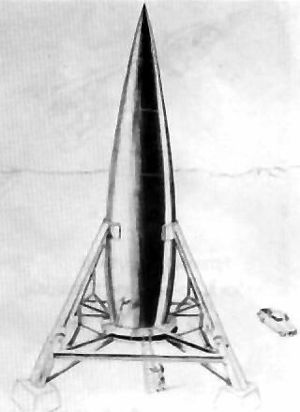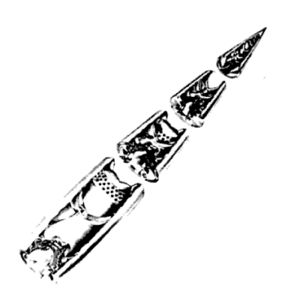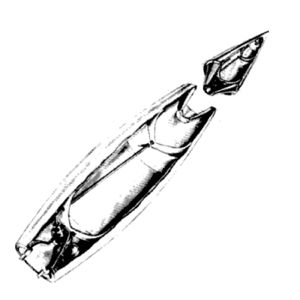
Home - Search - Browse - Alphabetic Index: 0- 1- 2- 3- 4- 5- 6- 7- 8- 9
A- B- C- D- E- F- G- H- I- J- K- L- M- N- O- P- Q- R- S- T- U- V- W- X- Y- Z
World Circling Space Ship
 RAND Ship Multistage World Circling Spaceship |
Status: Design 1946. Height: 20.00 m (65.00 ft). Diameter: 3.65 m (11.97 ft).
The US Navy's High Altitude Test Vehicle orbital launch vehicle design of spring 1946 brought about an immediate response - from the US Army Air Force, not the Soviets. It was considered vital for the USAAF to establish itself as the lead service in outer space. In April General Curtis LeMay asked the service's Project Rand think-tank to provide a comeback to the Navy on a crash basis. In just three weeks, sixteen Rand experts completed a 250-page engineering analysis of a "World-Circling Spaceship". Rand argued that "technology and experience have now reached the point where it is possible to design and construct craft which can penetrate the atmosphere and achieve sufficient velocity to become satellites of the earth." They stated that the USAAF could launch a 230-kg satellite into a 500-km orbit within five years at a cost of $150 million.
In the report's introduction, Rand team leader David Griggs predicted:
Though the crystal ball is cloudy, two things seem clear:The report's technical feasibility studies dealt with propulsion options, meteor strike risk assessments, trajectory analysis, and re-entry issues. In contrast to the Navy's single-stage-to-orbit HATV, Rand proposed a low-risk three-stage alcohol-oxygen rocket. Rand claimed it could identify no overwhelming technical challenges.
1. A satellite vehicle with appropriate instrumentation can be expected to be one of the most potent scientific tools of the Twentieth Century.
2. The achievement of a satellite craft by the United States would inflame the imagination of mankind, and would probably produce repercussions in the world comparable to the explosion of the atomic bomb.
The four-stage alcohol/liquid oxygen design would have a liftoff mass of 105,990 kg and a diameter of 4.0 m. A two-stage liquid oxygen/liquid hydrogen powered design would have a mass of 132,250 kg and a diameter of 6.3 m. However preliminary calculations for a three-stage liquid oxygen/liquid hydrogen design showed a launch mass of only 38,000 kg. These figures assumed aircraft-type fabrication techniques and no extraordinary weight-saving measures. The liquid oxygen/alcohol vehicle would have had a length of around 20 m.
Radar expert Louis N Ridenour examined potential military satellite missions. A satellite would provide a nearly invulnerable observation platform that could provide weather and bomb damage assessment data. Satellites could serve as communications relay stations. He noted that a satellite positioned at an altitude of 38,000 km would be a motionless radio beacon in the sky, since its "rotational period would be the same as that of the earth". Potential scientific missions included cosmic rays studies, precise gravitational measurements, astronomy, and biomedical studies on the effects of zero-G on organisms. Satellites could be used to provide radio navigation data to long-range missiles. He finally noted that:
There is little difference in design and performance between an intercontinental rocket missile and a satellite. Thus a rocket missile with a free space trajectory of 6,000 miles requires a minimum energy of launching which corresponds to an initial velocity of 4.4 miles per second, while a satellite requires 5.4 . Consequently, the development of a satellite will be directly applicable to the development of an intercontinental missile.Based on the Rand study, LeMay declined the Navy offer of a joint Navy-AAF satellite program at the May meeting of the Aeronautical Board. Instead he asserted the AAF's sole right to conduct American satellite operations . But despite the Rand report, the board members felt that satellites had questionable military utility. In that case the expense given could not be justified. However the Board agreed to permit both services to continue their studies. The issue of which would be responsible for the mission could be decided if it was ever decided to actually proceed with such systems.
The Rand report established the technical feasibility of orbiting a satellite. But nuclear warheads of the period weighed four metric tons, twenty times the payload of the planned launch vehicle. LeMay himself was (and would remain) antagonistic to long-range missiles as a threat to his beloved fleet of manned bombers. And the project board was clearly not interested in a anything that did not have use as an offensive weapons system.
In February 1947 Rand's James E Lipp produced a second, multi-volume study. It provided detailed specifications for a reconnaissance satellite system including a three-stage rocket booster with a gross weight of 37 metric tons, orbiting its payload at 560 km, and costing only $82 million to develop. Rand's analysis identified the need for fundamental research in such areas as guidance; orbital command, control, and communications; and reliable power sources. Solar power and miniaturized electronic equipment had not been developed at that time and were not considered.
The report further explored the use of satellites for communications relay and included the first detailed analysis of the optical instrument requirements for a space-based reconnaissance satellite. Lipp noted that other nations would pursue satellite development and that:
…the decision to carry through a satellite development is a matter of timing, depending upon whether this country can afford to wait an appreciable length of time before launching definite activity…The psychological effect of a satellite will in less dramatic fashion parallel that of the atom bomb. It will make possible an unspoken threat to every other nation that we can send a guided missile to any spot on earth … a satellite development program should be put in motion at the earliest time.But in the post-World War II budget environment, 'Buck Rogers' projects had no chance. The only American ICBM research program was cancelled in July 1947. In January 1948 USAF Chief of Staff Hoyt Vandenberg indicated that the USAF would continue satellite research efforts, but at a feasibility-study level only. The Navy attempted to join the Air Force again as a joint sponsor of the Rand project but failed to overcome the opposition of LeMay. By the end of 1948, the Navy "suspended" its satellite work and the American opportunity to orbit a satellite by the early 1950's was lost.
Family: orbital launch vehicle, Pre-Sputnik Designs. Country: USA. Agency: Rand.
 | RAND Ship SSTO |
 | Rand Ship on Pad |
1946 March 19 - . LV Family: HATV. Launch Vehicle: World Circling Space Ship.
- Project RAND - . Nation: USA. The Army Air Forces established Project RAND, which in part included the study of satellite applications..
1946 May 12 - . LV Family: HATV. Launch Vehicle: World Circling Space Ship.
- Preliminary Design of an Experimental World Circling Space Ship - . Nation: USA. Project RAND filed a report entitled 'Preliminary Design of an Experimental World Circling Space Ship,' which indicated the technical feasibility of building and launching an artificial satellite..
Back to top of page
Home - Search - Browse - Alphabetic Index: 0- 1- 2- 3- 4- 5- 6- 7- 8- 9
A- B- C- D- E- F- G- H- I- J- K- L- M- N- O- P- Q- R- S- T- U- V- W- X- Y- Z
© 1997-2019 Mark Wade - Contact
© / Conditions for Use